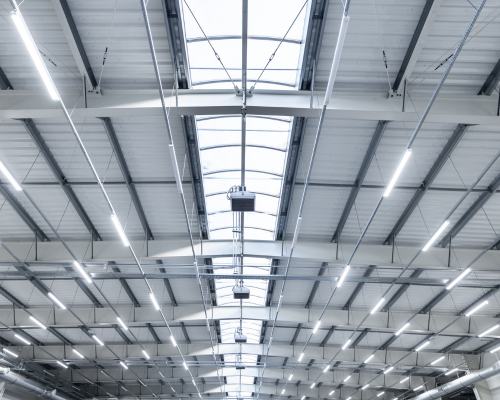October 28, 2025
Share this post
A transformation is sweeping across American cities, schools, businesses, and government buildings: a new era defined by clean lighting legislation and a race to replace obsolete, mercury-laden fluorescent bulbs with efficient, mercury-free LED technology. Over the past two years, states like California, Colorado, Hawaii, Illinois, Maine, Minnesota, Oregon, Rhode Island, Vermont, and Washington have enacted pioneering laws that will end the sale and distribution of almost all fluorescent lamps, quite literally turning the lights out on a legacy of energy waste and toxic pollution.1
As this transition unfolds, the switch to LED offers a strategic route for leaders in public and private sectors. It is an opportunity to modernize infrastructure, unlock budget-neutral energy performance contracts, and accelerate progress toward sustainability goals, while reaping the benefits of rapid paybacks, lower costs, and safer environments.
Legislation That’s Lighting the Way
Today, more than one-fifth of the U.S. population lives in states with active Clean Lighting Bills. Such measures phase out CFLs and linear fluorescents (T8, T5, T12) in nearly all markets. Implementation timelines move quickly, with bans beginning in Vermont as early as February 2023, with California, Oregon, Rhode Island, and others following suit through 2025. Illinois, the latest entrant, locks in bans for most fluorescent products by 2027.
This coordinated wave is driven by clear priorities. As Minnesota legislation notes, mercury is a dangerous neurotoxin, placing pregnant women and young children at the largest risk, since mercury exposure can impact the developing brain and nervous system, affecting learning abilities, memory, and attention.2 The persistent reality that every fluorescent lamp contains mercury means every break or improper disposal risks contaminating air, water, and workplaces. By 2050, states’ combined efforts could prevent an estimated 13.6 to 14.5 million metric tons of CO₂ emissions, comparable to eliminating millions of gasoline cars from American roads.3
Transition Now for Performance, Savings, and Safety
LED lighting is transforming how facility managers measure and achieve performance, savings, and safety. Unlike fluorescent bulbs, which use mercury vapor and glass construction, LEDs are solid-state electronics that convert up to 95% of electricity directly into useful light. Fluorescents lose much more energy to heat and increase wasted power.
A single LED fixture provides up to 44–75% higher energy efficiency than its fluorescent predecessor. Swapping out fluorescents for LEDs can halve lighting electricity costs. Minnesota alone estimates up to $68 million per year in annual energy bill reductions by 2030 and nearly $700 million in cumulative savings through 2050. With results grounded in actual performance data and evolving utility prices, the drive to transition is compelling.
LEDs also last approximately two to three times longer—often upwards of 100,000 operating hours compared to the typical 30,000–50,000 for fluorescents. This remarkable longevity, paired with the robust design of solid-state lights, dramatically reduces maintenance needs, ending routine work orders for flickering tubes and hazardous breakage.
Safety is an equally crucial consideration. Mercury, found in every fluorescent lamp, poses a severe threat to people responsible for maintaining, recycling, and disposing of these bulbs. Cracked tubes and improper handling risk health and environmental safety. LEDs sidestep those dangers entirely by eliminating mercury from the lighting equation. In any environment serving vulnerable populations, such as schools and medical facilities, the shift to mercury-free lighting is a matter of health protection.
LED upgrades also accelerate climate goals. Lighting accounts for a substantial portion of energy use in commercial buildings. Because LEDs use half the power and last twice as long, every upgrade delivers an immediate, long-term reduction in carbon emissions, making each fixture swap a tangible step toward broader ESG goals.
States like California are supporting this transition through innovative financing models. On-Bill Financing programs enable organizations to retrofit lighting with zero-interest loans repaid from the energy savings achieved monthly. This removes the barrier of upfront capital expenditure, letting organizations implement LED retrofits as budget-neutral projects and combine them with other energy conservation upgrades such as HVAC and building envelope improvements. The result is compounded savings, greater operational resilience, and instantaneous compliance with new legislative timelines.4
In April 2024, the U.S. Department of Energy finalized stringent efficiency standards for lightbulbs, scheduled to take effect in July 2028—potentially phasing out most fluorescent lighting products. Early adopters will capture the largest utility rebates and incentives, and also avoid future supply chain bottlenecks as demand spikes.5
To sum up this inflection point: LED conversion stands out as the most cost-effective, fast, and strategic energy-saving solution available to facility leaders. It reduces operating costs, eliminates toxic liabilities, secures compliance, and places organizations at the forefront of sustainable practices. The performance is proven, the savings are real, and legislative and market forces make this the ideal time to act.
Prioritizing Response
Procurement officers, facilities managers, and executive leaders should audit their facilities to identify all fluorescent and mercury-containing lights, preparing for upcoming replacement deadlines. Leveraging utility incentive programs will maximize cost savings before rebates are phased out. Bundling lighting upgrades with broader infrastructure projects, through mechanisms like Energy Savings Performance Contracts, achieves further efficiencies with minimal upfront investment. Working with experienced partners ensures high-quality solutions, regulatory compliance, and lasting returns.
The Field Guide to Decarbonization Planning
This free resource provides a tangible roadmap for organizations looking to reduce their carbon footprint and achieve net zero emissions. The built environment is responsible for roughly 40% of energy-related carbon emissions. This resource offers a holistic approach to cutting consumption, costs, and carbon and practical solutions for facility owners and operators.

